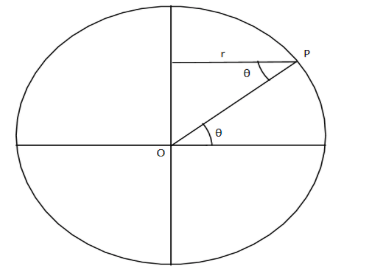
Find out the correct relation for the dependence of change in acceleration due to gravity on the angle at latitude due to rotation of Earth.
A. $dg{\text{ }}\alpha {\text{ cos}}\theta $
B. $dg{\text{ }}\alpha {\text{ co}}{{\text{s}}^2}\theta $
C. $dg{\text{ }}\alpha {\text{ co}}{{\text{s}}^{\dfrac{3}{2}}}\theta $
D. $dg{\text{ }}\alpha {\text{ }}\dfrac{1}{{{\text{ cos}}\theta }}$
Answer
565.2k+ views
Hint:The two forces that act on the Earth are the force due to gravity and the centrifugal force. Centrifugal force depends on the angle of latitude. So the resultant force changes with the angle of latitude. The resultant acceleration due to these forces is termed as the effective acceleration due to gravity. Derive the relation between effective gravity and angle of latitude by balancing the force to find the dependence of gravity on the angle of latitude.
Complete step by step solution:
On any point on the earth there acts the two forces which are force due to gravity and the centrifugal force due to the rotation of earth. This centrifugal force acts outwards hence decreasing the resultant force.
Let us consider Earth as a sphere of mass $M$ and radius$R$. Take an object of mass $m$at the point P at a latitude with the angle$\theta $. As the earth is rotating the object experiences the centrifugal force along with the force of gravity.

The object is moving in the circular path if radius $r$
The relation between $r$ and the radius of earth $R$ is given as
$r = R\cos \theta $
So the centrifugal force ${F_c} = m{\omega ^2}r = m{\omega ^2}R\cos \theta $
Let us represent the resultant acceleration as $g'$ or in other words the effective acceleration due to gravity.
Since the force is vector we will use the vector addition here, we get
${R^2} = {A^2} + {B^2} + 2AB\cos \phi $
${(mg')^2} = {(mg)^2} + {(m{\omega ^2}R\cos \theta )^2} + 2mg.m{\omega ^2}R\cos \theta \cos (180 - \theta )$
${m^2}{(g')^2} = {m^2}{(g)^2} + {m^2}{\omega ^4}{R^2}{\cos ^2}\theta + 2{m^2}g{\omega ^2}R{\cos ^2}\theta $
${(g')^2} = {(g)^2}\left( {1 + \dfrac{{{\omega ^4}{R^2}{{\cos }^2}\theta }}{{{g^2}}} - \dfrac{{2{\omega ^2}R{{\cos }^2}\theta }}{g}} \right)$
For earth the value of angular velocity $\omega $ is $7.29 \times {10^{ - 5}}$ so we will neglect the terms containing ${\omega ^4}$
So we have
${(g')^2} = {(g)^2}\left( {1 - \dfrac{{2{\omega ^2}R{{\cos }^2}\theta }}{g}} \right)$
$(g') = (g){\left( {1 - \dfrac{{2{\omega ^2}R{{\cos }^2}\theta }}{g}} \right)^{\dfrac{1}{2}}}$
Using the binomial expansion and neglecting the higher power terms we get that
$(g') = (g)\left( {1 - \dfrac{1}{2}.\dfrac{{2{\omega ^2}R{{\cos }^2}\theta }}{g}} \right)$
$g' = g - {\omega ^2}R{\cos ^2}\theta $
$g - g' = {\omega ^2}R{\cos ^2}\theta $
For small angle $\theta $ $g - g' = dg$
So $dg = {\omega ^2}R{\cos ^2}\theta $
$dg\alpha {\cos ^2}\theta $
Option B is correct.
Note:The main key in the question is considering the centrifugal force along with force due to gravity and vector addition of force. Take care while taking the components.
Complete step by step solution:
On any point on the earth there acts the two forces which are force due to gravity and the centrifugal force due to the rotation of earth. This centrifugal force acts outwards hence decreasing the resultant force.
Let us consider Earth as a sphere of mass $M$ and radius$R$. Take an object of mass $m$at the point P at a latitude with the angle$\theta $. As the earth is rotating the object experiences the centrifugal force along with the force of gravity.

The object is moving in the circular path if radius $r$
The relation between $r$ and the radius of earth $R$ is given as
$r = R\cos \theta $
So the centrifugal force ${F_c} = m{\omega ^2}r = m{\omega ^2}R\cos \theta $
Let us represent the resultant acceleration as $g'$ or in other words the effective acceleration due to gravity.
Since the force is vector we will use the vector addition here, we get
${R^2} = {A^2} + {B^2} + 2AB\cos \phi $
${(mg')^2} = {(mg)^2} + {(m{\omega ^2}R\cos \theta )^2} + 2mg.m{\omega ^2}R\cos \theta \cos (180 - \theta )$
${m^2}{(g')^2} = {m^2}{(g)^2} + {m^2}{\omega ^4}{R^2}{\cos ^2}\theta + 2{m^2}g{\omega ^2}R{\cos ^2}\theta $
${(g')^2} = {(g)^2}\left( {1 + \dfrac{{{\omega ^4}{R^2}{{\cos }^2}\theta }}{{{g^2}}} - \dfrac{{2{\omega ^2}R{{\cos }^2}\theta }}{g}} \right)$
For earth the value of angular velocity $\omega $ is $7.29 \times {10^{ - 5}}$ so we will neglect the terms containing ${\omega ^4}$
So we have
${(g')^2} = {(g)^2}\left( {1 - \dfrac{{2{\omega ^2}R{{\cos }^2}\theta }}{g}} \right)$
$(g') = (g){\left( {1 - \dfrac{{2{\omega ^2}R{{\cos }^2}\theta }}{g}} \right)^{\dfrac{1}{2}}}$
Using the binomial expansion and neglecting the higher power terms we get that
$(g') = (g)\left( {1 - \dfrac{1}{2}.\dfrac{{2{\omega ^2}R{{\cos }^2}\theta }}{g}} \right)$
$g' = g - {\omega ^2}R{\cos ^2}\theta $
$g - g' = {\omega ^2}R{\cos ^2}\theta $
For small angle $\theta $ $g - g' = dg$
So $dg = {\omega ^2}R{\cos ^2}\theta $
$dg\alpha {\cos ^2}\theta $
Option B is correct.
Note:The main key in the question is considering the centrifugal force along with force due to gravity and vector addition of force. Take care while taking the components.
Recently Updated Pages
Master Class 8 Maths: Engaging Questions & Answers for Success

Class 8 Question and Answer - Your Ultimate Solutions Guide

Master Class 7 Maths: Engaging Questions & Answers for Success

Class 7 Question and Answer - Your Ultimate Solutions Guide

Master Class 6 Maths: Engaging Questions & Answers for Success

Class 6 Question and Answer - Your Ultimate Solutions Guide

Trending doubts
What is meant by exothermic and endothermic reactions class 11 chemistry CBSE

Which animal has three hearts class 11 biology CBSE

10 examples of friction in our daily life

One Metric ton is equal to kg A 10000 B 1000 C 100 class 11 physics CBSE

1 Quintal is equal to a 110 kg b 10 kg c 100kg d 1000 class 11 physics CBSE

Difference Between Prokaryotic Cells and Eukaryotic Cells




